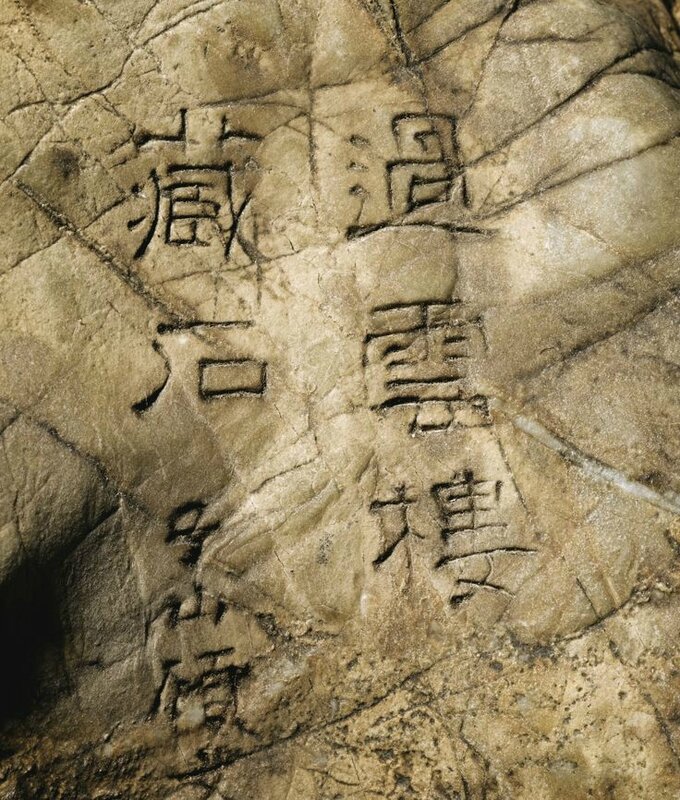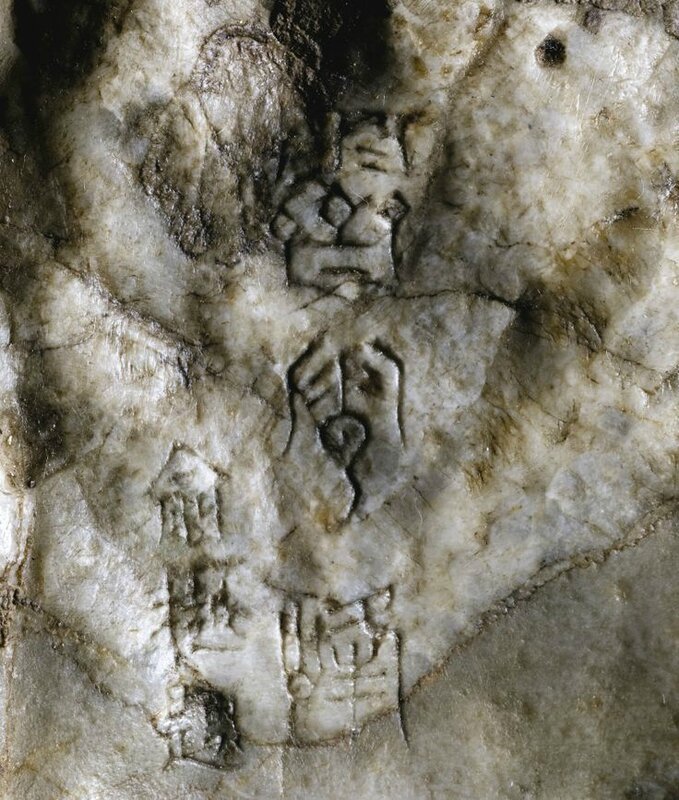A 'Lingbi' scholar's rock, Qing dynasty
Lot 3670. A 'Lingbi' scholar's rock, Qing dynasty; overall height 68.8 cm., 27 in. Estimate 1,800,000 — 2,500,000 HKD. Lot sold 2,200,000 HKD. Photo: Sotheby's
the medium-grey limestone naturally shaped in the form of a three-peaked mountain landscape, with the centre peak the tallest, inscribed Guoyunlou cang shi, Zishan Gu Wenbin (‘Rock in the Guoyunlou Collection, [recorded by] Zishan, Gu Wenbin’) on the left side and on the right, Jiyun Feng, Yu Yue ti (‘Peak of Clouds after Rain, inscribed by Yu Yue’), six-footed hongmu stand.
Provenance: The Guoyunlou collection, Suzhou.
Mist and Clouds Passing Through One’s Eyes, As the Time Goes By: The Guoyunlou Collection
The renowned Qing-dynasty official Gu Wenbin amassed a renowned collection of masterpieces of painting and calligraphy, and housed it in his Suzhou residence Guoyunlou, the Pavilion of Passing Clouds.
Gu Wenbin (1811-1889) was a native of Yuanhe (now Suzhou). His formal name was Weiru, and his sobriquets were Zishan and Gen’an, the latter adopted late in his life. After earning the Metropolitan Graduate degree in 1841, he served in various departments including the Ministry of Justice and Salt Control Circuit of Wuchang. Passionate about painting and calligraphy and especially skilled in writing lyric poetry, Gu was the author of Meilülou ci [Lyric poetry from Meilülou]. In Suzhou, he associated with like-minded literati, such as Li Hongyi (1831-1885), and Wu Yun (1811-1883). The painting Seven Elders of the Wu Region by the Qing painter Hu Gan, now in the Nanjing Museum, depicts seven elegant literati, including Gu, with art and literary accoutrements (fig. 1). A resourceful collector and sensitive connoisseur, Gu Wenbin devoted himself to antiquities and collected many invaluable works of painting and calligraphy by famous masters of past dynasties, which he kept at Guoyunlou.
Fig. 1. Hu Gan, Seven Elders of the Wu Region, detail, Nanjing Museum, after: Xu Huping, Nanjing Bowuguan zhencang xilie: Ming Qing xiaoxiang hua, Tianjin, 2003, plate 62
In Suzhou at the end of the Tongzhi reign, Gu Wenbin refurbished and expanded the Fuyuan (Garden of Restoration) estate formerly belonging to Wu Kuan (1435-1504) and built his own Yiyuan (Garden of the Agreeable) and Guoyunlou on the site. The garden was named after the line xiongdi yiyi ('mutually agreeable like brothers') in the Analects, suggesting harmony, longevity, and tranquillity. Inspired by famous works of art, the landscape scenes in the garden were ingeniously designed, with intriguing and poetically evocative artificial mountains. The Qing-dynasty writer Yu Yue (1821-1907) wrote in their praise that “the mountains are full of miraculous peaks, encapsulating the best of nature.” A masterpiece of traditional Chinese garden design, Yiyuan was widely renowned and a frequent gathering place for literati at the time.
In his Banghuitang ji, the Song-dynasty literatus Su Shi (1037-1011) wrote that a collection was “like mist and clouds passing through one’s eyes.” Gu understood this, and wrote in his preface to Guoyunluo shuhua ji [Records of Paintings and Calligraphy in Guoyunlou] that “Master Zizhan [Su Shi] thought that paintings and calligraphy are mist and clouds passing through one’s eyes. I agree with his words and thus have named my collection of treasures after them. I gather these things for safe-keeping and record them for posterity. I simply encounter them as agreeable things and do not fixate on them.” Although Gu realized that his possessions were only temporary, he still treasured what he came across. He called his studio Guoyunlou. It was a place to learn from the ancients through old books and artefacts.
Guoyunlou contained over 800 old books, manuscripts, rubbings, and seal catalogues, reaching as far back as Tang and Jin dynasties. Famous paintings and works of calligraphy in Guoyunlou included Chu Suiliang’s copy of the Preface to the Orchid Pavilion Anthology with an inscription by Mi Fu. Gu Wenbin also had a rich collection of antiquities, including a qin zither, named Yujian liuquan ('Jade stream'). It is said that Gu also possessed Shang- and Zhou-dynasty bronzes, but they were dispersed during wartime. Gu wrote the ten-volume catalogue Guoyunlou shuhuaji [Paintings and Calligraphy in Guoyunlou], and his grandson Gu Linshi (1865-1930) wrote Guoyunlou xu shuhuaji [Paintings and Calligraphy in Guoyunlou, Continued]. These catalogues list the masterpieces in Guoyunlou but unfortunately omit objects and works on silk, stone, silk damask, and fans.
The gregarious Gu Wenbin generously hosted learned scholars and sympathetic friends, available his collection for their study and enjoyment. The late-Qing painters Ren Xun (1835-1893) and Hu Gan (1839-1883) both copied ancient works at Guoyunlou. The subsequent establishment of the Yiyuan Painting Society was immensely influential in art circles. Its members, including the renowned artists and scholars Wu Dacheng (1835-1902), and Wu Changshuo (1844-1927) gathered in Yiyuan and studied the Guoyunlou treasures.
One-hundred and fifty years after Gu Wenbin passed away, the books in Guoyunlou are now mostly kept at the Nanjing Library. Some of them are in private hands, while others are in museum collections. Artefacts and stationery from Guoyunlou are rarely available on the auction market. As witnesses of history, these objects accompanied countless famous scholars and master artists in their art viewing in Guoyunlou.
Sotheby's. Contemporary Literati — A Gathering, Hong Kong, 07 april 2014

/https%3A%2F%2Fprofilepics.canalblog.com%2Fprofilepics%2F1%2F0%2F100183.jpg)
/https%3A%2F%2Fstorage.canalblog.com%2F03%2F02%2F119589%2F96711876_o.jpg)
/https%3A%2F%2Fstorage.canalblog.com%2F11%2F31%2F119589%2F94773502_o.jpg)
/https%3A%2F%2Fstorage.canalblog.com%2F20%2F83%2F119589%2F94772815_o.jpg)
/https%3A%2F%2Fstorage.canalblog.com%2F26%2F72%2F119589%2F75604929_o.jpg)
/https%3A%2F%2Fstorage.canalblog.com%2F59%2F60%2F119589%2F26458628_o.jpg)






/image%2F1371349%2F20240423%2Fob_af8bb4_telechargement-6.jpg)
/image%2F1371349%2F20240423%2Fob_b6c4a6_telechargement.jpg)
/image%2F1371349%2F20240416%2Fob_65a1d8_telechargement-31.jpg)
/image%2F1371349%2F20240331%2Fob_7209d9_117-1.jpg)